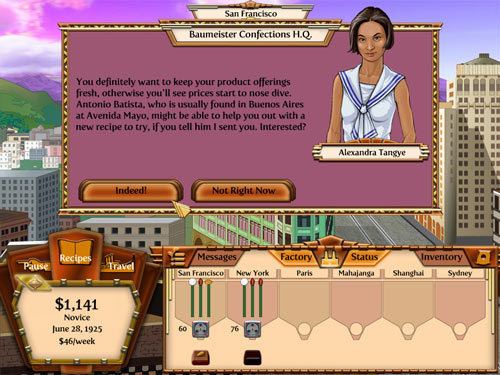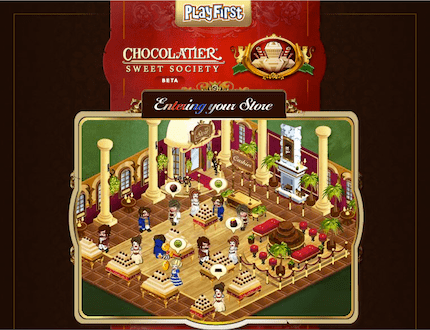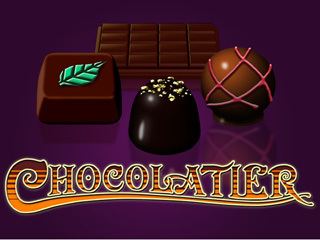9.4 /10 1 Votes
Initial release date May 2007 | 94% GameHouse Engine Playground SDK™ Developer Big Splash Games LLC | |||||||||||||||||||||||||||||||||
 | ||||||||||||||||||||||||||||||||||
Release date(s) Download:May 1, 2007Retail:NA: September 27, 2007 Mode(s) Story Mode, Free Play Mode Similar PlayFirst games, Economic simulation games, Other games | ||||||||||||||||||||||||||||||||||
Chocolatier is a casual strategy video game with action game elements, developed by Big Splash Games and published by PlayFirst. The game was released as a download on May 1, 2007 and was followed by CD-ROM release on September 27, 2007. Players assume the role of a young Chocolatier, who must navigate 14 cities around the globe while buying ingredients, manufacturing chocolates, and selling them to chocolate shops. Two modes of play are available: in story mode the player must rebuild an almost bankrupt chocolate empire and acquire 64 chocolate recipes from around the world; in free mode players start out with scant resources and must become successful chocolatiers.
Contents

Chocolatier was the first game developed by Big Splash Games, a trio of experienced video game designers, who remained employees whilst developing a prototype game in their spare time. This prototype was rejected by Publisher(s), but after coming up with the premise of Chocolatier the team was signed-up by PlayFirst and completed the title. The game received a mostly positive reception: reviewers enjoyed the action mini-game which is played when chocolates are manufactured, and the game's graphics, sound, and Victorian-era presentation.

Gameplay

The player assumes the role of a young chocolatier in 1880, during the Victorian era. The game has two modes of play: story and free play. Story mode involves a number of quests, including delivering specific chocolates and restoring the fictional Baumeister chocolate empire to its former glory. The player is enlisted by Evangeline Baumeister to rebuild the Baumeister chocolate empire which has been ruined by Evangeline's younger sister who scattered chocolate recipes around the world. The player must locate the 64 lost recipes, visit 14 different cities around the globe, purchase 6 closed Baumeister factories, establish business relationships with outlets and suppliers, and manufacture chocolates to keep in business. Free play mode allows the player to travel, manufacture, and trade without undertaking quests. This mode starts the player with a small amount of cash and all chocolate recipes unlocked for use. In story mode, players begin with a single factory and a recipe for simple chocolate bars, the player must visit the market to purchase ingredients and begin the manufacturing process.
The game is turn-based. Each turn represents one week, and travelling between cities takes a number of turns depending on the proximity of the destination city. Many cities have a chocolate shop, where the player can sell his or her stock, and a market where ingredients can be purchased. Some specialty cacao beans can only be purchased from plantations in certain cities. Factories manufacturing chocolates produce a set amount of product every turn, as long as the required ingredients are in stock. During story mode, quests are given by non-player characters; these typically involve producing a particular volume and type of chocolate and delivering it to another non-player character, who is either traveling or can be found at a set location. Quest rewards take the form of a high price for the chocolates or a new recipe. Some encounters with characters give the player an opportunity to gamble a large amount of money on a dice roll. Market owners can be bartered with, though this carries the risk of them becoming irritated and raising prices rather than lowering them.
When producing a particular chocolate for the first time, a mini-game is played where ingredients are fired from a cannon to fill circular trays which revolve around the cannon. The ingredients and quantities needed vary, depending on the recipe. Each time a circle is filled with the correct ingredients, it is removed and an empty circle put in its place. The trays spin faster as more circles are filled. If too many ingredients are wasted by misfiring the cannon, production is brought to a halt and the mini-game must be attempted again. The mini-game ends when the timer runs out; the number of completed circles is equal to the number of chocolates produced by that factory every week. The mini-game cannot be played unless the player owns the correct ingredients, and it can be replayed if the player wishes to try to improve the efficiency of the factory. Playing the mini-game advances in-game time by one week. Different chocolate types, such as truffles and squares, require the factory to be upgraded first, costing money.
Development
Tucson, Arizona based Big Splash Games was formed in late 2005 by three veterans of the videogame industry: Jon Blossom, Stephen Lewis and Michael Wyman. They came together to produce a prototype video game for the casual market. They worked on this for a few months when they were not working (they still held jobs within the industry to support themselves). This prototype was pitched to a few publishers in order to gain feedback. PlayFirst, though not interested in the prototype, issued the team a request for proposal for an economic simulation game, hoping that Big Splash could produce another proposal. The next morning, Big Splash co-founder Stephen Lewis remembered that he had been told that some people, in particular women, "have an almost religious connection with chocolate". Taking this idea he quickly wrote a proposal and forwarded it to his two partners. After brainstorming the idea the team decided that it satisfied PlayFirst's request for proposal, forwarded a copy of the idea and received word from the publisher that they "had hit the nail on the head".
Chocolatier was designed to appeal to women aged between 35 and 55, a different market compared to the games previously developed by the trio. In order to immerse themselves in the subject matter during development, Big Splash's staff tasted as many variety of chocolates as they could find and took the Scharffen Berger Chocolate Maker factory tour, where they witnessed the full "bean to bar" process. The factory mini-game was developed in order to give players a break from the economic side of the game, which involves buying low and selling high. It took approximately the same time to produce the mini-game as it did to create the rest of the game, which drained the developer's resources, though Stephen Lewis believed this was "the right decision". Journalists were sent Chocolatier-branded chocolate bars and "golden tickets" which allowed them to download the game for free, in order to promote the game's release. The game's sequel, Chocolatier 2: Secret Ingredients was first released on November 27, 2007. Chocolatier: Decadence by Design is the third installment, released in 2009. The Great Chocolate Chase: A Chocolatier Twist was later released by PlayFirst.
Reception
Chocolatier was awarded Gamezebo's Zeeby award for best strategy game of 2007. The game received a positive response from critics, though GameZone's Anise Hollingshead found the game too easy, noting "there really isn’t a whole lot of thinking involved." other reviewers called it "a delightfully challenging business tycoon game", "challenging but not frustratingly so", and said that the game "turned out as beautifully as the chocolates." The game's graphics and sound received praise: Marc Saltzman noted "the game's wonderful art style and delightful music", but website Killer Betties' Jason Van Horn found the graphics "alright, simply doing what it needs to do to get its gameplay across."
Reviewers praised the amount of freedom given to players, Meryl Evans of Blogcritics stated "There was no right or wrong, or a set path you must take", but added that the game lost pace when she had gathered a large amount of money and had to find a specific character to speak with before completing her current quest. After finding the non-player character, the game "picked up again and kept me hopping for the rest of it." Didi Cardoso of website Grrl Gamer also enjoyed the freedom, but noted that sometimes she felt lost and was unsure of how to find the location of the next recipe. The chocolate manufacturing mini-game was also praised as "fun". Peter Cohen of Macworld noted that some fans of business simulators might find the mini-game "off-putting", but also suggested that it helped break up gameplay. Marc Saltzman expressed the same opinion, while Anise Hollingshead found the mini-game to be too easy to play.
